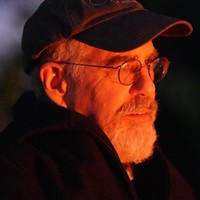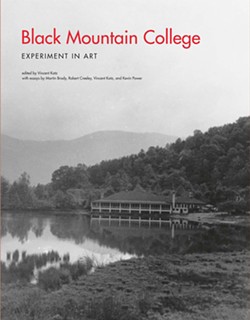[
{
"name": "Top Stories Video Pair",
"insertPoint": "7",
"component": "17087298",
"parentWrapperClass": "fdn-ads-inline-content-block",
"requiredCountToDisplay": "1"
}
]
That mid-20th century artistic innovations happened in New York, Paris and San Francisco is no surprise, but rural North Carolina? It's all but forgotten now, but for 23 years many of those who defined American arts came to an isolated YMCA camp in the Blue Ridge Mountains to teach, learn, collaborate and create.
Black Mountain College began in 1933 as an experiment in higher education, but the arts were always an important component and so was the idea of cross-fertilization. The first inspiration was the Bauhaus movement in Germany, which advocated arts and crafts on an equal footing. Among the first Black Mountain teachers were Bauhaus painter Josef Albers and his wife (and craftsperson) Anni Albers.
The remarkable landscape of mountains and lake and the natural quiet drew artists from New York and elsewhere to teach — some periodically, some continuously for years. Some students in turn became prominent.
There were the inevitable problems of a small hothouse campus, of strong convictions, egos and hormones. But there were also historic moments that seem unlikely to have happened anywhere else. For example, there was a rare production of a play by composer Erik Satie, directed by future filmmaker Arthur Penn, with music performed by John Cage, dancing by Merce Cunningham, sets painted by artist Willem de Kooning, and starring Buckminster Fuller, who took time off from teaching how to make geodesic domes to play the outrageous lead character.
This generously illustrated volume emphasizes the visual arts, but the text and additional essays cover greater ground. These include an essay by poet Robert Creeley about working with visionary poet Charles Olson — two highly influential literary figures in the 1960s and beyond.
Though most of the big names associated with Black Mountain are male (including artists Robert Rauchenberg and Robert Motherwell, composers Lou Harrison and Roger Sessions, and poet Robert Duncan), many women and lesser-known men were just as important there, and are well represented in the text and illustrated artworks.
Since these legendary figures defined American arts and established American artists as world leaders, the Black Mountain College story is historically important. The setting — so different from the usual urban-dominated history — is itself fascinating.
Within this narrative, there is the equally important sense of Black Mountain College as an experiment in education that was influential for decades, though the idea of experimental colleges seems sadly to have nearly died out. With an emphasis on teaching process, Black Mountain College was (in the words of one teacher) a place where people were more interested in what they didn't know than in what they did.
These two aspects — creativity and educational experiment — are linked, and this volume is a solid beginning in exploring those links.
Speaking of Books
-

Open-Air Poetry Reading with David Holper
Sep 28, 2023 -

Book Drive Promoting Equity and Boosting Local Bookstores
Mar 8, 2021 -

Pull Up for Library Curbside
Jun 4, 2020 - More »
more from the author
-
TV or Not TV?
A Comic Dilemma at NCRT
- Sep 25, 2014
-
Unequivocal Success
Shakespeare in trouble at Redwood Curtain
- Sep 11, 2014
-
A Midsummer Night's Stage
Magic worlds at Redwood Park
- Aug 14, 2014
- More »
































